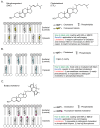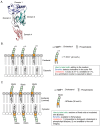Domain 4 (D4) of Perfringolysin O to Visualize Cholesterol in Cellular Membranes-The Update
- PMID: 28273804
- PMCID: PMC5375790
- DOI: 10.3390/s17030504
Domain 4 (D4) of Perfringolysin O to Visualize Cholesterol in Cellular Membranes-The Update
Abstract
The cellular membrane of eukaryotes consists of phospholipids, sphingolipids, cholesterol and membrane proteins. Among them, cholesterol is crucial for various cellular events (e.g., signaling, viral/bacterial infection, and membrane trafficking) in addition to its essential role as an ingredient of steroid hormones, vitamin D, and bile acids. From a micro-perspective, at the plasma membrane, recent emerging evidence strongly suggests the existence of lipid nanodomains formed with cholesterol and phospholipids (e.g., sphingomyelin, phosphatidylserine). Thus, it is important to elucidate how cholesterol behaves in membranes and how the behavior of cholesterol is regulated at the molecular level. To elucidate the complexed characteristics of cholesterol in cellular membranes, a couple of useful biosensors that enable us to visualize cholesterol in cellular membranes have been recently developed by utilizing domain 4 (D4) of Perfringolysin O (PFO, theta toxin), a cholesterol-binding toxin. This review highlights the current progress on development of novel cholesterol biosensors that uncover new insights of cholesterol in cellular membranes.
Keywords: D4; Perfringolysin O; cholesterol probes; domain 4; microscopy; theta toxin; visualization.
Conflict of interest statement
The author declares no competing interests.
Figures





Similar articles
-
Perfringolysin O Theta Toxin as a Tool to Monitor the Distribution and Inhomogeneity of Cholesterol in Cellular Membranes.Toxins (Basel). 2016 Mar 8;8(3):67. doi: 10.3390/toxins8030067. Toxins (Basel). 2016. PMID: 27005662 Free PMC article. Review.
-
Perfringolysin O, a cholesterol-binding cytolysin, as a probe for lipid rafts.Anaerobe. 2004 Apr;10(2):125-34. doi: 10.1016/j.anaerobe.2003.09.003. Anaerobe. 2004. PMID: 16701509
-
Cholesterol exposure at the membrane surface is necessary and sufficient to trigger perfringolysin O binding.Biochemistry. 2009 May 12;48(18):3977-87. doi: 10.1021/bi9002309. Biochemistry. 2009. PMID: 19292457 Free PMC article.
-
Detection of esterified cholesterol in murine Bruch's membrane wholemounts with a perfringolysin O-based cholesterol marker.Invest Ophthalmol Vis Sci. 2014 Jul 1;55(8):4759-67. doi: 10.1167/iovs.14-14311. Invest Ophthalmol Vis Sci. 2014. PMID: 24985479
-
Cholesterol-binding toxins and anti-cholesterol antibodies as structural probes for cholesterol localization.Subcell Biochem. 2010;51:597-621. doi: 10.1007/978-90-481-8622-8_22. Subcell Biochem. 2010. PMID: 20213560 Review.
Cited by
-
Coupled sterol synthesis and transport machineries at ER-endocytic contact sites.J Cell Biol. 2021 Oct 4;220(10):e202010016. doi: 10.1083/jcb.202010016. Epub 2021 Jul 20. J Cell Biol. 2021. PMID: 34283201 Free PMC article.
-
Visualize neuronal membrane cholesterol with split-fluorescent protein tagged YDQA sensor.J Lipid Res. 2025 May;66(5):100781. doi: 10.1016/j.jlr.2025.100781. Epub 2025 Mar 19. J Lipid Res. 2025. PMID: 40118459 Free PMC article.
-
Differential Lipid Binding Specificities of RAP1A and RAP1B are Encoded by the Amino Acid Sequence of the Membrane Anchors.J Am Chem Soc. 2024 Jul 24;146(29):19782-19791. doi: 10.1021/jacs.4c02183. Epub 2024 Jul 13. J Am Chem Soc. 2024. PMID: 39001846 Free PMC article.
-
A novel sterol-binding protein reveals heterogeneous cholesterol distribution in neurite outgrowth and in late endosomes/lysosomes.Cell Mol Life Sci. 2022 May 29;79(6):324. doi: 10.1007/s00018-022-04339-6. Cell Mol Life Sci. 2022. PMID: 35644822 Free PMC article.
-
Ca2+-dependent vesicular and non-vesicular lipid transfer controls hypoosmotic plasma membrane expansion.BMC Biol. 2025 Jul 9;23(1):207. doi: 10.1186/s12915-025-02309-5. BMC Biol. 2025. PMID: 40629316 Free PMC article.
References
Publication types
MeSH terms
Substances
LinkOut - more resources
Full Text Sources
Other Literature Sources

